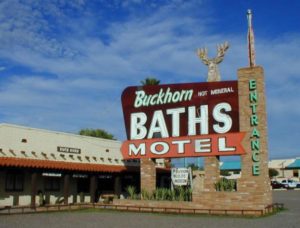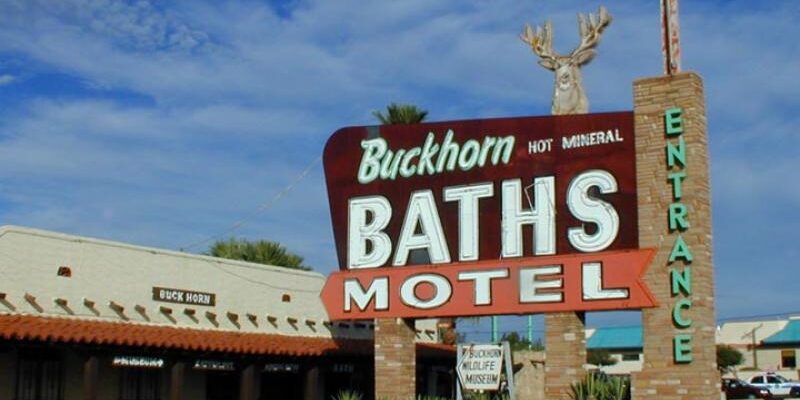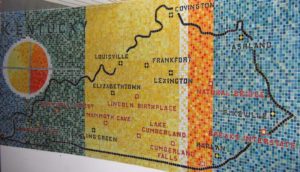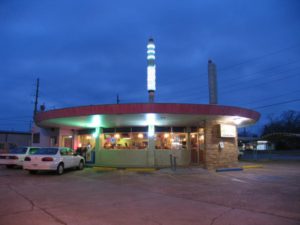 No. 1: Buckhorn Baths
No. 1: Buckhorn Baths
5964 East Main Street
Mesa, AZ
United States
Buckhorn Baths, a ten-acre oasis of palms, gardens and Spanish bungalows, sits along Mesa’s busy Main Street, a reminder of the town’s former life as a desert resort community. Closed for over a decade, future restoration and reuse of the property is growing less likely as the surrounding area redevelops for commercial use.
History: The business opened as a service station in 1926 on US Highway 60, the Apache Trail. During expansion of the establishment in the 1930s, the owners discovered a mineral well on the property, and constructed Roman-style bathhouses and guesthouses for visitors. In the 1940s the baths played a role in bringing the New York Giants spring training camp to Mesa, leading to the eventual establishment of Mesa as a center for baseball spring training. The resort remained open and operated by its original owner until 1999. The buildings are remarkably intact, which helped their listing on the National Register of Historic Places in 2005.
Threat: The property has been for sale since 1999. It is still owned by the original owner, Alice Sliger, who is in advance of 100 years old. It is feared that if a suitable buyer does not come forward, the property could be sold for redevelopment. Buckhorn Baths is located in a transitional area that is currently undergoing redevelopment—including a new Walgreens across the street. In 2007, the Arizona Preservation Foundation included the property on the Arizona’s Most Endangered Historic Places list.
Owner: Alice Sliger, 480-823-1111
Advocate: Vic Linoff, Mesa Historical Museum Board, 408-835-7358
Photo courtesy Emily Koller
 No. 2: California’s Roadside Orange Stands
No. 2: California’s Roadside Orange Stands
United States
Before it was the Inland Empire, it was the Orange Empire. Long stretches of US Highway 66 once passed through California’s picture postcard landscapes of citrus orchards. Dotted along the highway were fruit stands shaped like oversized oranges. Here tourists could pick up a bag of fruit and delight to a glass of fresh squeezed orange juice. With the widening of highways and spread of suburban growth after WW II, the orchards, along with their stands, soon disappeared. Now only a few are left scattered across California.
History: Oranges blossom, back-dropped by snow covered mountains, form an enduring image of Southern California. Tourists driving Route 66 between San Bernardino and Monrovia inhaled the sweet smell of the citrus orchards lining the highway. Similar scenes were seen on US Highway 99, tracing through the agricultural middle section of the state. In the 1920s, with the rise of auto tourism, enterprising citrus ranchers opened roadside fruit stands. Stands designed to look like huge oranges were an innovation to the fruit selling. From a window in the “orange,” attendants sold bags of fruit, snacks, and, of course, fresh juice.
Threat: Constructed of wood or fiberglass, the giant oranges were not designed to last. Changes in land use patterns and the widening of highways resulted in destruction or relocating dozens of these stands. Now only a handful still exist in California: in Dixon, San Jose, Williams, Chowchilla, Shasta Lake and Fontana—most of them moved and none selling orange juice. While Fontana’s Orange Stand was saved from demolition, it now sits restored but unused in the parking lot of Bono’s Italian Restaurant and Deli.
 No. 3: Clark County Rest Area
No. 3: Clark County Rest Area
United States
Like a mushroom, the I-64, Clark County, Kentucky rest stop rises from a small knoll, surrounded by greenery. Designed in the early 1960s, it is however wholly modern, with a folded plate roof and strong concrete and glass composition. Inside the circular space, a tile mosaic map of Kentucky stretches along a curving wall. Despite its architectural significance, the Kentucky Transportation Cabinet may demolish this space-age rest stop.
History: Designed in 1962 by the notable Louisville modern architecture firm Sweet & Judd, the rest area was built two years later, one of four of the same design on the Kentucky Interstate System. Only two exist today. In 2005 the Clark County Rest Area was included on the Federal Highway Administration’s list of exceptionally significant features of the national Interstate Highway System.
10: In 1996 a long-range plan issued by the Kentucky Transportation Cabinet for rest area development called for the removal of the building. In 2009 a consultant assessed the building and its sister rest area for their structural integrity. The report estimated $300,000 in maintenance and rehabilitation costs. In response, the Kentucky Transportation Cabinet Maintenance Division recommended demolishing both rest stops. Additionally, a proposed new interchange at the exit of the Clark County rest area would require demolishing the building; the project is expected to be considered within the next year.
Photo courtesy Joanna Dowling
 No. 4: Pig Stand Coffee Shop No. 41
No. 4: Pig Stand Coffee Shop No. 41
United States
A horseshoe shaped building, tinted purple and green, with an adjacent wavy carhop, the Pig Stand Coffee Shop in Beaumont, Texas is a classic post-war drive-in. But for all of its neon and flying saucer design, the owner of the closed restaurant cannot find a new tenant, and threatens demolition.
History: Built in 1941, No. 41 is the most distinctive and architecturally significant of the Pig Stand chain, which started in Dallas in 1921. For over 60 years, the Beaumont restaurant served pig sandwiches—the chain’s signature—and delivered shakes and fries to cars parked under the canopy. It closed in 2006. The significant architectural design of No. 41 includes its circular shape and twin roof pylons, spelling “PIG STAND” in neon, and its distinctive carhop canopy. The property has been determined eligible for listing on the National Register of Historic Places. Threat: The owner recently threatened demolition and proposed replacing it with a gas station and convenience store.
Photo courtesy Beth Dodd
No. 5: Motel Drive
United States
Motel Drive—a strangely desolate strip of highway devoid of operating motels—defines, for better or worse, Lordsburg, New Mexico. At one end an abandoned café announces “Trucker’s Breakfast, Only $3.50,” and at the other is a boarded up nightclub, while in between is a parade of eviscerated motels, some missing roofs and others with their pools full of garbage. Things were different before the interstate.
History: Lordsburg, a city in central-south New Mexico, benefited for years from being located, like a curb along a street, on the edge of US Highways 70 and 80—proudly announcing in its newspaper in the 1930s that it was on the Broadway of America. In 1964, Lordsburg boasted 21 motels, 20 cafes and 31 service stations—making it the biggest gas-food-and-lodging stop between Arizona and Texas. But less than ten years later, the completion of Interstate 10 took it all away. The State Highway Department tried to appease Lordsburg merchants, promising to build the interstate at a slightly higher elevation so that travelers could look down and “see” their businesses. But this failed, and the interstate dealt a crippling blow to Lordsburg, a trauma from which it has never recovered.
Threat: Motel Drive continues to decline, with only one motel offering overnight service. While the three-mile strip offers a catalogue of mid-century roadside commercial architecture, the interstate continues to direct travelers and their business to another part of town.
No. 6: Dinosaur World
United States
The sign at the entry of Dinosaur World in northwest Arkansas announces the park is “CLOSED Until Further Notice.” And beyond, in a heavily wooded, 65-acre designed landscape, nearly 100 prehistoric replicas, remain unvisited. Closed for five years, the future of the “largest dinosaur park in the world” is uncertain.
History: Built in 1960 and originally known as John Agar’s Land of Kong, Dinosaur World was a tourist attraction touted as the largest dinosaur park in the world. The life-size concrete dinosaurs were observed along a two-mile road, requiring visitors to use a car if they wanted to see all of them. The prehistoric replicas were created by Emmit Sullivan, a sculptor who had fashioned similar creatures for Dinosaur Park in Rapid City, South Dakota, and the famous Christ of the Ozarks statue, in nearby Eureka Springs. The park served as an opening scene for the 1968 horror movie “It’s Alive.” Closed in 2005, presumably much of the park is still intact, but deteriorating.
Threat: Dinosaur World remains closed; plans for its future are unknown.
 No. 7: Garrison Concourse
No. 7: Garrison Concourse
United States
Sitting along a curve of U.S. Highway 169, in the tiny town of Garrison, Minnesota is a pullout to a stone-edged rest area built by the CCC. Landscaped with mature trees and with a sweeping view across Mille Lacs Lake, and a more recent addition of a huge walleye sculpture, it is the town’s only tourist attraction. Years of deferred maintenance have put the structure in a precarious position; urgent advocacy is needed to stabilize and restore the historic wayside.
History: The concourse was built between 1936 and 1939 by Civilian Conservation Corps Camp SP-15, one of four camps in Minnesota dedicated to roadside development projects. It was the cornerstone of highway improvements in the region. Collectively, the work represents the most extensive roadside development project undertaken by the CCC in the state. In 1990, it was determined eligible for the National Register of Historic Places for its design and as a rare Federal Relief property, significant to the history of roadside development.
Threat: The threat facing the Garrison Concourse is primarily one of lack of maintenance. Most crucial is the condition of the overlook wall, the base of which is under water and deteriorating. One concern is the structural integrity of the wall: if action is not taken to stabilize it, the entire structure could be lost. Lack of funding is a barrier to preservation and stabilization efforts. Nomination of this property to the “most endangered” list is supported by the Minnesota Department of Transportation and the Preservation Alliance of Minnesota.
Photo courtesy MN Dept.of Transportation
No. 8: Vale-Rio Diner
United States
Fabricated in 1948, the Vale-Rio Diner sat at the intersection of Nutt Road and Bridge Street for 60 years, serving up food to residents and workers at the Phoenix Iron Company and local textile mills. Like many diners, it was shiny and silver, but distinguished by an unusual pattern of stainless steel circles along its exterior. It was, as one reviewer called “a classic greasy spoon with horrible service.” But progress, in the way of a new Walgreens, pushed it from its coveted location to a storage lot several miles away, where its sits with an unknown future.
History: Paramount Diners of Oakland, New Jersey, fabricated the diner in 1948, which opened in Phoenixville, a town at the confluence of French Creek and Schuylkill River, on Thanksgiving of that year. It operated at its original location for 60 years, becoming a landmark for local residents. During the last weekend of operation, a line of people formed out the door and onto the sidewalk. The unusual disk pattern on its stainless steel exterior is known to exist on only one other diner: the 11th Street Diner in Miami Beach, Florida.
Threat: The diner closed in 2008 when the lot on which it stood was sold. The diner was moved to a presumably temporary location for storage and has remained unused. Plans for its future are uncertain.
No. 9: Tex Randall
United States
Looking over US Highway 60, the big cowboy leans on his knee, staring at traffic with a bemused smile. Constructed in 1959, Tex Randall—47’ feet high and seven tons heavy—is a landmark in the Texas Panhandle. But exposure, lack of maintenance and an unknown future is threatening the roadside giant.
History: Tex Randall was constructed by industrial arts teacher Harry Wheeler in 1959 out of concrete, steel and wire mesh. Originally known as “The Biggest Texan,” the cowboy advertised Wheeler’s Western Store, holding a cigarette and wearing real denim jeans and a red checkered shirt. Tex was restored in 1989 after a semi crashed into his left boot. Local businesses rallied around the cause, starting the “Save the Cowboy” campaign. Though deteriorated, Tex Randall remains a visual landmark in the Texas Panhandle.
Threat: Wheeler’s Western Store, which Tex once towered over, has been long closed and the building sits vacant. Discussions of redevelopment for the property have involved removing the statue. In 2008 a restaurant owner in Canyon reportedly purchased the statue to move it to his business, but was unable to complete his plan when moving and reinstallation costs were estimated at $50,000. Current plans for the cowboy are unknown.
No. 10: Teapot Dome Gas Station
United States
Constructed in 1922 to look like an actual teapot—with handle, spout and top—this gas station paid tribute to the infamous Teapot Dome Scandal. Today the iconic roadside structure sits vacant on the outskirts of Zillah, 15 miles southeast of Yakima.
History: Constructed by Jack Ainsworth, the form of the building referenced the infamous controversy which clouded Warren G. Harding’s presidency. Originally located along US Highway 410, the construction of Interstate 82 forced the removal of the building from its original location in 1978. It is listed on the National Register of Historic Places and is widely recognized as a significant roadside icon and one of the few tangible reminders of the 80-year-old scandal.
Threat: The building has stood vacant for several years. The Washington Trust for Historic Preservation placed it on its 2007 Most Endangered Historic Properties list. The Friends of the Teapot Association formed with the intention of moving the structure to nearby Zillah for use as a visitor/tourism center. But the move and its restoration were priced at $250,000. The Friends group continues to raise money, but the rare roadside attraction sits unused.



 No. 2: California’s Roadside Orange Stands
No. 2: California’s Roadside Orange Stands No. 3: Clark County Rest Area
No. 3: Clark County Rest Area No. 4: Pig Stand Coffee Shop No. 41
No. 4: Pig Stand Coffee Shop No. 41 No. 7: Garrison Concourse
No. 7: Garrison Concourse